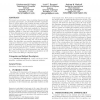33 search results - page 6 / 7 » Evolutionary motion design for humanoid robots |
GECCO
2009
Springer
14 years 1 days ago
2009
Springer
We present a novel stereo vision modeling framework that generates approximate, yet physically-plausible representations of objects rather than creating accurate models that are c...
IROS
2007
IEEE
14 years 1 months ago
2007
IEEE
— Human walking emerges from synergy of whole body dynamics: not only legs, but also a torso, arms, and a head are compliantly connected with each other by antagonistic muscles. ...
ECAL
1995
Springer
13 years 11 months ago
1995
Springer
Neither `design' nor `evolutionary' approaches to building behavior-based robots feature a role for development in the genesis of behavioral organization. However, the n...
TSMC
2008
13 years 7 months ago
2008
Recent studies have shown that the perception of natural movements--in the sense of being "humanlike"--depends on both joint and task space characteristics of the movemen...
ICRA
2007
IEEE
14 years 1 months ago
2007
IEEE
— One of the most notable and recognizable features of robot motion is the abrupt transitions between actions in action sequences. In contrast, humans and animals perform sequenc...

